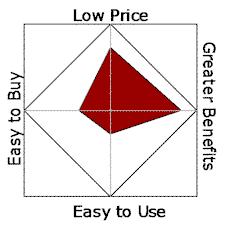| If you’re wondering why you’ve seen so little original thought on these pages of late, it’s because I can’t seem to shake the post-vacation blues. ‘Til they’re gone, I’ll keep relaying good ideas and inspirations from others.
The formula is based on Clay Christensen‘s description of what ‘filling an unmet need’ really means: When a consumer buys a product, they are really ‘hiring’ it to get a job done. Companies are successful when they make it easier for their customers to get done what they were already trying to do.
Mankin says that a product that ‘makes it easier for customers to get done what they were already trying to do’ must meet four criteria:
Rate your new product or service according to these new criteria, and you’ll have a pretty good assessment of the likelihood of success of your new business. A lot of cheaply-made, environmentally damaging and wasteful products, like the new cheap disposable toothbrushes, the Swiffer products, and the endless rounds of ‘disposable wipes’ of every description meet criteria 2, 3 and 4 very well, and for buyers who think only of short-term cost, criterion 1 as well, and they have been very successful. The vast majority of new technologies, including Social Networking tools, fail to meet criteria 3 and (because they’re only available to computer users) 4, and are doomed to fail until they simplify adoption and broaden their reach (see diagram above). Clever innovators know the only way around criterion 1 is to develop a product or service that is unique, and has no existing alternatives, which is why great new ideas like TiVo, and the pioneering products from companies like Sony, are initially priced steeply, to recoup the costs of development quickly. Perception is reality, and skeptics might argue that the purpose of advertising is to convince people that every new product meets these criteria, but I have more respect for the average consumer than that. I believe advertising does nothing more than raise awareness of a new product’s availability. Regardless of the cleverness of the message, most consumers will assess each product on the basis of how well it meets the four criteria above for them personally, and will discount any commercial that tries to do that thinking for them. The easiest way for entrepreneurs to meet these criteria is:
If more innovators and entrepreneurs had Mankin’s formula in front of them as they developed their products and services, I think the success rate of new innovations would be a lot higher. Thanks to Innovation Weekly for the link. |

 It’s been said that there are no new ideas in the world, just unique and clever ways of re-combining and articulating the old ones. A recent
It’s been said that there are no new ideas in the world, just unique and clever ways of re-combining and articulating the old ones. A recent 



It might be interesting to take some example entrepreneurial success stories and compare the Mankin metrics with equivalent metrics in the ‘tetrad’ dimensions of Marshall McLuhan’s Laws of Media, ie, chart the relative strengths in terms of Retrieval – everything new contains some existing elements from the cultural inventory, — in Mankin’s terms, it gets the job done and does so in a familiar way, often reaching back over the previous generation to pull some lost feature from the generation that preceeded the current status quo.Enhancement – new contrivances provide improved performance compared to the old, even if this is not the obvious strength of the replaced product! Consider how the image in digital photography is vastly inferior to emulsions, but the other benefits (convenience, cost, immediacy) far outweigh those other benefits of film.Obsolescence – new contrivances render previous models or versions passé, even though the old may have some superior qualities; once again, digital imaging is a good example — Kodak is abandoning the film emulsion business.Reversal – most often overlooked, we tend to over-do the new, until we run out of benefits and into detriments; it’s too early to say for digital photography, but among young writers there is a sense that the human tactile experience and mechanical pacing of the typewriter was lost in the office-steno optimization of the word processor, which perhaps may suggest entrepreneurial opportunity for a more human (and less strictly business oriented) computer keyboard.For those who want to get a better handle on what Marshal and Eric were getting at, and if you like such things, there is a free download of a powerpoint presentation — I wonder if Derrick and Mark are right on the timeline in publishing McLuhan for Managers …
On a different topic, any idea how to get consumers to properly calculate #1? (lower price) I know hybrids have become more popular as people started considering gas costs (though a smaller car will also cost less in terms of insurance which will end up being a bigger savings than the gas). Should we be gumming up the works? Joining every fight against opening a new landfill? How can we move past the disposable society?
Gary: That’s an interesting mapping. Marshall was definitely ahead of his time. And thanks for the links.Derek: I’ve suggested to Consumer Reports that when they publish tables of the ratings of cars vs. their costs, they add to the cost of each vehicle the predicted cost of driving it say 20000 km/year and maintaining it (given its historical repair record). I think we’d be astonished to learn the full cost of a lot of the things we buy. Information — full information — is the key, I think, to changing behaviour.